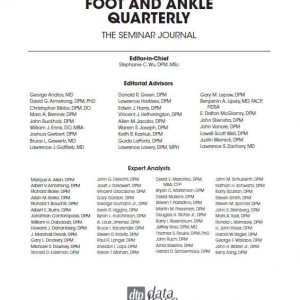33-1 Managing and Monitoring the Physical Activity of Patients with Diabetic Foot Disease
$88.00
EDITORIAL
» Caring for the diabetic foot remains a monumental task for those entrusted with providing care to the lower extremities.
A confluence of numerous factors affect the health of the diabetic foot. Although there is certainly an association between diabetic foot disease and physical activity engagement, this relationship is nuanced and still not fully understood. While too much weightbearing activity can result in the formation of diabetic foot ulcers or prohibit healing, activity avoidance is clearly problematic for overall health and likely detrimental to maintaining resilience of the soft tissue of non-ulcerated diabetic feet. As such, there is likely a “Goldilocks” paradigm in place in which there is a level (or range) of physical activity that is “just right” for each person. This issue’s two audio lectures dive into the challenges of determining that just right dosage of activity for each patient. They also explore timely themes pertaining to the diabetic foot, including COVID-19 and the concept of maintaining activity-rich days for those patients in diabetic foot disease “remission.”
This issue’s commentaries present critical reviews of the latest literature pertaining to managing and monitoring physical activity profiles of patients with diabetic foot disease. In addition to considering the implications of the literature for care providers and patients, the contributors to this issue also address the larger ecosystem of healthcare by considering the role of healthcare payers in promoting lower extremity health. A sampling of the topics addressed by the original manuscripts reviewed by commentators includes: quantification of physical activity profiles, recommendations for managing physical activity levels, advances in offloading the diabetic foot to ensure safe participation in physical activity, and the use of foot temperature monitoring as an early warning system for times when physical activity should be dialed back.
It has been my great privilege to serve as the Guest Editor for this issue of Foot and Ankle Quarterly, and I am immensely grateful to my colleagues that kindly accepted the invitation to join me on this adventure. The international team that has come together for this issue is an all-star roster of clinicians and academics within the field of the diabetic foot. I hope you as a reader will come away from this issue better enabled to partner with patients in managing that “just right” level of physical activity engagement for each patient at each phase of their journey with diabetic foot disease.
Ryan T. Crews, PhD, CCRP
Description
In This Issue
- FEATURE ARTICLE: Physical Activity and the Diabetic Foot: Measuring What We Intend to Manage
Ryan T. Crews, PhD, CCRP - CONDENSATIONS and COMMENTARIES
- Should Weightbearing Activity Be Reduced during Healing of Plantar Diabetic Foot Ulcers, Even when Using Appropriate Offloading Devices?
Commentary by Neil D. Reeves, PhD - Lower Resource Utilization for Patients with Healed Diabetic Foot Ulcers during Participation in a Prevention Program with Foot Temperature Monitoring
Commentary by James Wrobel, DPM - Mobility Advice to Help Prevent Re-Ulceration in Diabetes
Commentary by Peter A. Lazzarini, PhD - Innovative Intelligent Insole System Reduces Diabetic Foot Ulcer Recurrence at Plantar Sites: A Prospective, Randomized, Proof-of-Concept Study
Commentary by Dyane E. Tower, DPM - Short-Term Strength and Balance Training Does Not Improve Quality of Life but Improves Functional Status in Individuals with Diabetic Peripheral Neuropathy: A Randomized Controlled Trial
Commentary by Annabelle L. Dookie, DPM - Moderate-to-Vigorous-Intensity Physical Activity Observed in People with Diabetes-Related Foot Ulcers over a One-Week Period
Commentary by Joseph Candela, DPM, PhD - Ulcer-Free, Hospital-Free and Activity-Rich Days: Three Key Metrics for the Diabetic Foot in Remission
Commentary by Crystal Holmes, DPM - Physical Training and Activity in People with Diabetic Peripheral Neuropathy: Paradigm Shift
Commentary by Chia-Ding (JD) Shih, DPM, MPH, MA - Factors Associated with Wearing Inadequate Outdoor Footwear in Populations at Risk of Foot Ulceration: A Cross-Sectional Study
Commentary by Brian D. Lepow, DPM - Heel-Rise and Non-Weightbearing Ankle Plantar Flexion Tasks to Assess Foot and Ankle Function in People with Diabetes Mellitus and Peripheral Neuropathy
Commentary by Frank Bowling, DPM
- Should Weightbearing Activity Be Reduced during Healing of Plantar Diabetic Foot Ulcers, Even when Using Appropriate Offloading Devices?
- AUDIO LECTURE 1: Physical Activity is Important for Those with Diabetic Peripheral Neuropathy
Patricia Kluding, PT, PhD - AUDIO LECTURE 2: Excessive Physical Activity Engagement by Those with Diabetic Foot Disease is a Bigger Concern than Engaging in Too Little
Malindu E. Fernando, MBBS, PhD, Virginie Blanchette, DPM, PhD and David G. Armstrong, DPM, MD, PhD - CONTINUING EDUCATION QUESTIONNAIRE
Related products
-
Sale!

Volume 33 – Complete – Four Issues
$298.00Original price was: $298.00.$260.00Current price is: $260.00. Add to cart -

33-3 Exploring the Impact of Artificial Intelligence on Care Delivery
$88.00 Add to cart -

33-4 Trauma of the Foot and Ankle
$88.00 Add to cart -

33-2 Podiatry and Medicine in the Age of Social Media
$88.00 Add to cart

